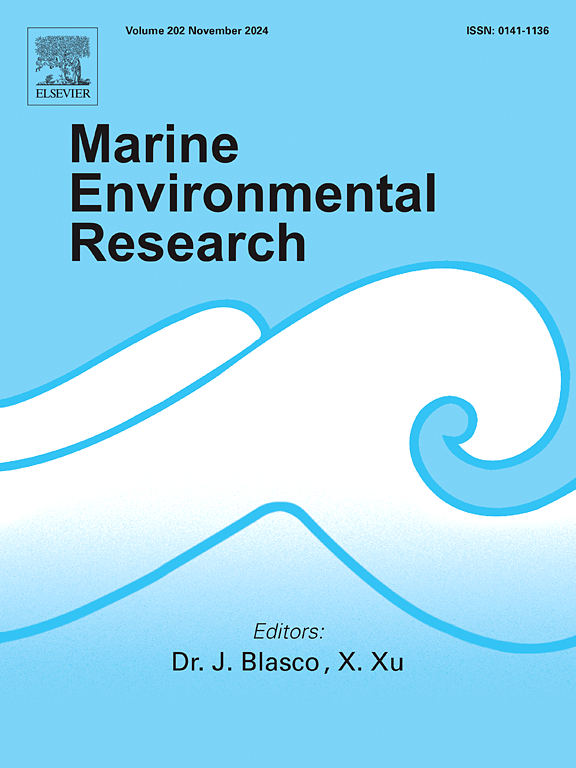Harnessing melanin from deep-sea yeast Hortaea werneckii NIOT129A8: Heavy metal adsorption potential
IF 3
3区 环境科学与生态学
Q2 ENVIRONMENTAL SCIENCES
引用次数: 0
Abstract
Marine organisms are recognized for their unique ability to detoxify heavy metals through chelation, effectively sequestering and reducing metal ion toxicity. This study focuses on the deep-sea yeast Hortaea werneckii NIOT129A8, which exhibits a unique adaptation for melanin production, a compound known for its chelating properties that can be harnessed to sequester and detoxify metal ions. Sequencing of the internal transcribed spacer (ITS) region and translation elongation factor (TEF) gene showed similarity of 99.2 % and 96.1 %, respectively with H. werneckii type strain CBS 107.67, presenting it as a potentially new strain from the deep sea. Growth conditions were optimized to maximize melanised biomass production, targeting cost-effective media. The study employed diverse spectroscopic analyses such as EPR, FTIR and NMR, to confirm the presence and structural properties of melanin within the yeast. The melanised ghost cells demonstrated effective shielding against UV-C exposure and maintained 50–70 % E. coli growth across various exposure times. An analysis of H. werneckii biomass treatments with NaOH and phosphorylation was conducted to evaluate their efficiency in heavy metal biosorption in which the former exhibited high removal efficiencies for Cu2+ (79 %), Pb2+ (76 %), Cr6+ (75 %), Cd2+ (74 %), Ni2+ (73 %), and Co2+ (69 %), emphasizing the importance of pretreatment in enhancing adsorption properties. The findings highlight the potential of deep-sea yeast strain NIOT129A8 as a bio-adsorbent in bioremediation applications, particularly due to its adaptability, cost-effective production, and high metal-binding efficiencies.
利用深海酵母NIOT129A8提取黑色素:重金属吸附潜力
海洋生物以其独特的通过螯合解毒重金属的能力,有效地隔离和降低金属离子毒性。这项研究的重点是深海酵母Hortaea werneckii NIOT129A8,它对黑色素的产生具有独特的适应性,黑色素是一种以螯合特性而闻名的化合物,可以用来隔离和解毒金属离子。内部转录间隔区(ITS)和翻译延伸因子(TEF)基因序列与H. werneckii型菌株CBS 107.67的相似性分别为99.2%和96.1%,表明该菌株可能是来自深海的新菌株。优化了生长条件,以最大限度地提高黑化生物质产量,目标是具有成本效益的培养基。该研究采用了多种光谱分析,如EPR、FTIR和NMR,以确认酵母中黑色素的存在和结构特性。黑化的鬼细胞显示出对UV-C暴露的有效屏蔽,并在不同的暴露时间内保持50 - 70%的大肠杆菌生长。通过分析NaOH和磷酸化处理对H. werneckii生物质的重金属吸附效果,前者对Cu2+(79%)、Pb2+(76%)、Cr6+(75%)、Cd2+(74%)、Ni2+(73%)和Co2+(69%)的去除率较高,强调了预处理对提高吸附性能的重要性。这些发现突出了深海酵母菌NIOT129A8作为生物吸附剂在生物修复应用中的潜力,特别是由于它的适应性、生产成本效益和高金属结合效率。
本文章由计算机程序翻译,如有差异,请以英文原文为准。
求助全文
约1分钟内获得全文
求助全文
来源期刊

Marine environmental research
环境科学-毒理学
CiteScore
5.90
自引率
3.00%
发文量
217
审稿时长
46 days
期刊介绍:
Marine Environmental Research publishes original research papers on chemical, physical, and biological interactions in the oceans and coastal waters. The journal serves as a forum for new information on biology, chemistry, and toxicology and syntheses that advance understanding of marine environmental processes.
Submission of multidisciplinary studies is encouraged. Studies that utilize experimental approaches to clarify the roles of anthropogenic and natural causes of changes in marine ecosystems are especially welcome, as are those studies that represent new developments of a theoretical or conceptual aspect of marine science. All papers published in this journal are reviewed by qualified peers prior to acceptance and publication. Examples of topics considered to be appropriate for the journal include, but are not limited to, the following:
– The extent, persistence, and consequences of change and the recovery from such change in natural marine systems
– The biochemical, physiological, and ecological consequences of contaminants to marine organisms and ecosystems
– The biogeochemistry of naturally occurring and anthropogenic substances
– Models that describe and predict the above processes
– Monitoring studies, to the extent that their results provide new information on functional processes
– Methodological papers describing improved quantitative techniques for the marine sciences.
 求助内容:
求助内容: 应助结果提醒方式:
应助结果提醒方式:


